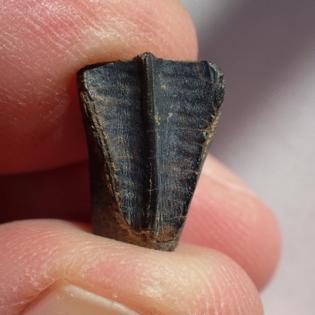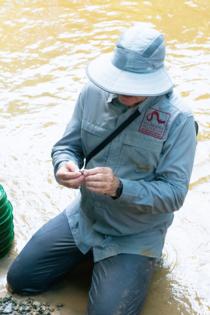Oddity from Alabama creek is tooth of dinosaur that reached 30 feet, experts say
Published in Science & Technology News
A “shiny” fossil found in an Alabama creek has been identified as the tooth of a large dinosaur that doesn’t quite belong at the site, experts say.
Hadrosaurs were land-dwellers, but the tooth surfaced in a spot that was underwater during the age of dinosaurs, according to the Alabama Museum of Natural History.
The tooth was discovered in gravel by Dr. John Friel, director of the Alabama Museum of Natural History, as he accompanied a group of fossil enthusiasts to a creek about a 50-mile drive southwest from the University of Alabama campus in Tuscaloosa.
“I have been doing these trips for the past ten years, but this was the first time I have ever found a dinosaur fossil,” Friel told McClatchy News in an email.
“When I first picked it up, I thought it was just another odd piece of bone that I would not be able to identify further. However, when I turned it over and saw that it had a shiny enameled surface with a distinctive texture, I was fairly certain it was a tooth.”
Two university paleontologists were included in the group that day, and both confirmed it was likely a hadrosaur tooth, he said.
Technically, it’s just the base of a tooth, but it is still more than a half inch long.
Hadrosaurs were duck-billed herbivores that grew to about 30 to 50 feet in length, and “had hundreds of teeth,” Fossil Era reports. They were also fast, and “may have been able to outrun a T-rex.”
It’s taken educated guesswork to explain how the tooth got in the stream.
The water cuts through a layer of sediment that “formed roughly 84 million years ago when this part of Alabama was submerged under the sea,” Friel said. Visitors typically find ancient shark’s teeth and internal molds of ammonites and oyster shells.
“Dinosaur fossils are very uncommon in Alabama since there are no surface deposits of Jurassic age,” Friel said.
“All of the dinosaur fossils discovered in Alabama are thought to be of dinosaurs that died and were then washed out to sea where they were likely scavenged by sharks or other marine creatures before they were fossilized.”
The tooth was added to the museum’s research collection and could be included in a future exhibit, he said.
©2025 Miami Herald. Visit at miamiherald.com. Distributed by Tribune Content Agency, LLC.










Comments